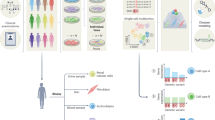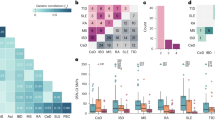Abstract
A mouse model was used to study the genetic control of differential host response to pulmonary infection with Chlamydia pneumoniae. The A/J and C57BL/6 strains show differential response to intranasal infection with respect to their ability to clear pulmonary bacterial load and the extent of lung pathology developed by 2 weeks post infection. The genetic basis of this interstrain difference was studied by whole-genome scan in an informative [A/J × C57BL/6J] F2 cross using the pulmonary microbial load as a phenotypic readout of host response. We detected a highly significant linkage (LOD score=11.5) on chromosome 17 that overlaps with the major histocompatibility (MHC) locus. This quantitative trait locus (QTL) accounts for ∼30% of the phenotypic variance with B6 alleles conferring susceptibility and inherited in a recessive fashion. Significant linkage was also detected to chromosome 5 in female mice, while chromosome 6 showed suggestive linkage in male mice, pointing to additional complexity in the genetic control of the difference in susceptibility observed in A/J and C57BL/6J.
This is a preview of subscription content, access via your institution
Access options
Subscribe to this journal
Receive 6 digital issues and online access to articles
$119.00 per year
only $19.83 per issue
Buy this article
- Purchase on Springer Link
- Instant access to full article PDF
Prices may be subject to local taxes which are calculated during checkout




Similar content being viewed by others
References
Kuo CC, Jackson LA, Campbell LA, Grayston JT . Chlamydia pneumoniae (TWAR). Clin Microbiol Rev 1995; 8: 451–461.
Von HL, Vasankari T, Liippo K, Wahlstrom E, Puolakkainen M . Chlamydia pneumoniae and severity of asthma. Scand J Infect Dis 2002; 34: 22–27.
Campbell LA, Kuo CC . Chlamydia pneumoniae—an infectious risk factor for atherosclerosis? Nat Rev Microbiol 2004; 2: 23–32.
Balin BJ, Gerard HC, Arking EJ, Appelt DM, Branigan PJ, Abrams JT et al. Identification and localization of Chlamydia pneumoniae in the Alzheimer's brain. Med Microbiol Immunol (Berl) 1998; 187: 23–42.
Rottenberg ME, Gigliotti-Rothfuchs A, Wigzell H . The role of IFN-gamma in the outcome of chlamydial infection. Curr Opin Immunol 2002; 14: 444–451.
Geng Y, Berencsi K, Gyulai Z, Valyi-Nagy T, Gonczol E, Trinchieri G . Roles of interleukin-12 and gamma interferon in murine Chlamydia pneumoniae infection. Infect Immun 2000; 68: 2245–2253.
Rottenberg ME, Gigliotti Rothfuchs AC, Gigliotti D, Svanholm C, Bandholtz L, Wigzell H . Role of innate and adaptive immunity in the outcome of primary infection with Chlamydia pneumoniae, as analyzed in genetically modified mice. J Immunol 1999; 162: 2829–2836.
Penttila JM, Anttila M, Varkila K, Puolakkainen M, Sarvas M, Makela PH et al. Depletion of CD8+ cells abolishes memory in acquired immunity against Chlamydia pneumoniae in BALB/c mice. Immunology 1999; 97: 490–496.
Halme S, Latvala J, Karttunen R, Palatsi I, Saikku P, Surcel HM . Cell-mediated immune response during primary Chlamydia pneumoniae infection. Infect Immun 2000; 68: 7156–7158.
Morrison SG, Su H, Caldwell HD, Morrison RP . Immunity to murine Chlamydia trachomatis genital tract reinfection involves B cells and CD4(+) T cells but not CD8(+) T cells. Infect Immun 2000; 68: 6979–6987.
Beatty WL, Byrne GI, Morrison RP . Repeated and persistent infection with Chlamydia and the development of chronic inflammation and disease. Trends Microbiol 1994; 2: 94–98.
Huang J, Wang MD, Lenz S, Gao D, Kaltenboeck B . IL-12 administered during Chlamydia psittaci lung infection in mice confers immediate and long-term protection and reduces macrophage inflammatory protein-2 level and neutrophil infiltration in lung tissue. J Immunol 1999; 162: 2217–2226.
Huang J, DeGraves FJ, Lenz SD, Gao D, Feng P, Li D et al. The quantity of nitric oxide released by macrophages regulates Chlamydia-induced disease. Proc Natl Acad Sci USA 2002; 99: 3914–3919.
Vuola JM, Puurula V, Anttila M, Makela PH, Rautonen N . Acquired immunity to Chlamydia pneumoniae is dependent on gamma interferon in two mouse strains that initially differ in this respect after primary challenge. Infect Immun 2000; 68: 960–964.
Li D, Borovkov A, Vaglenov A, Wang C, Kim T, Gao D et al. Mouse model of respiratory Chlamydia pneumoniae infection for a genomic screen of subunit vaccine candidates. Vaccine 2006; 24: 2917–2927.
DeGraves FJ, Gao D, Kaltenboeck B . High-sensitivity quantitative PCR platform. Biotechniques 2003; 34: 106–110; 112–5.
Broman KW . Mapping quantitative trait loci in the case of a spike in the phenotype distribution. Genetics 2003; 163: 1169–1175.
Manly KF, Cudmore Jr RH, Meer JM . Map Manager QTX, cross-platform software for genetic mapping. Mamm Genome 2001; 12: 930–932.
Broman KW, Wu H, Sen S, Churchill GA . R/qtl: QTL mapping in experimental crosses. Bioinformatics 2003; 19: 889–890.
Allcock RJ, Martin AM, Price P . The mouse as a model for the effects of MHC genes on human disease. Immunol Today 2000; 21: 328–332.
Gruen JR, Weissman SM . Evolving views of the major histocompatibility complex. Blood 1997; 90: 4252–4265.
Kimani J, Maclean IW, Bwayo JJ, MacDonald K, Oyugi J, Maitha GM et al. Risk factors for Chlamydia trachomatis pelvic inflammatory disease among sex workers in Nairobi, Kenya. J Infect Dis 1996; 173: 1437–1444.
Wang C, Tang J, Geisler WM, Crowley-Nowick PA, Wilson CM, Kaslow RA . Human leukocyte antigen and cytokine gene variants as predictors of recurrent Chlamydia trachomatis infection in high-risk adolescents. J Infect Dis 2005; 191: 1084–1092.
Conway DJ, Holland MJ, Bailey RL, Campbell AE, Mahdi OS, Jennings R et al. Scarring trachoma is associated with polymorphism in the tumor necrosis factor alpha (TNF-alpha) gene promoter and with elevated TNF-alpha levels in tear fluid. Infect Immun 1997; 65: 1003–1006.
Natividad A, Hanchard N, Holland MJ, Mahdi OS, Diakite M, Rockett K et al. Genetic variation at the TNF locus and the risk of severe sequelae of ocular Chlamydia trachomatis infection in Gambians. Genes Immun 2007; 8: 288–295.
Morrison RP, Feilzer K, Tumas DB . Gene knockout mice establish a primary protective role for major histocompatibility complex class II-restricted responses in Chlamydia trachomatis genital tract infection. Infect Immun 1995; 63: 4661–4668.
Qiu H, Wang S, Yang J, Fan Y, Joyee AG, Han X et al. Resistance to chlamydial lung infection is dependent on major histocompatibility complex as well as non-major histocompatibility complex determinants. Immunology 2005; 116: 499–506.
Bernstein-Hanley I, Balsara ZR, Ulmer W, Coers J, Starnbach MN, Dietrich WF . Genetic analysis of susceptibility to Chlamydia trachomatis in mouse. Genes Immun 2006; 7: 122–129.
Bernstein-Hanley I, Coers J, Balsara ZR, Taylor GA, Starnbach MN, Dietrich WF . The p47 GTPases Igtp and Irgb10 map to the Chlamydia trachomatis susceptibility locus Ctrq-3 and mediate cellular resistance in mice. Proc Natl Acad Sci USA 2006; 103: 14092–14097.
Li D, Vaglenov A, Kim T, Wang C, Gao D, Kaltenboeck B . High-yield culture and purification of Chlamydiaceae bacteria. J Microbiol Methods 2005; 61: 17–24.
Fortin A, Diez E, Rochefort D, Laroche L, Malo D, Rouleau GA et al. Recombinant congenic strains derived from A/J and C57BL/6J: a tool for genetic dissection of complex traits. Genomics 2001; 74: 21–35.
Acknowledgements
We thank Susan Gauthier for assistance with the breeding of the mice. This work was supported by NIH Public Health Service RO1 Grant AI47202 to BK. GM is supported by a CIHR Canada Graduate Scholarship, and PG is supported by a James McGill Professorship. The authors have no competing financial interests.
Author information
Authors and Affiliations
Corresponding author
Rights and permissions
About this article
Cite this article
Min-Oo, G., Lindqvist, L., Vaglenov, A. et al. Genetic control of susceptibility to pulmonary infection with Chlamydia pneumoniae in the mouse. Genes Immun 9, 383–388 (2008). https://doi.org/10.1038/sj.gene.6364450
Received:
Revised:
Accepted:
Published:
Issue Date:
DOI: https://doi.org/10.1038/sj.gene.6364450
Keywords
This article is cited by
-
Gene-specific sex effects on eosinophil infiltration in leishmaniasis
Biology of Sex Differences (2016)
-
Sex differences in the genetic architecture of susceptibility to Cryptococcus neoformans pulmonary infection
Genes & Immunity (2008)



